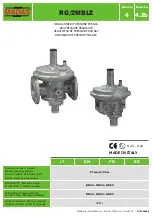
IT
EN
FR
ES
13
Madas Technical Manual
- 4|4.2b - REV. 0 of 1
st
Apr 2019
RG/2MBLZ
3.2 - INSTALLATION
(see example in 3.4)
Threaded devices:
• Assemble the device by screwing it, with the due seals, onto the plant with pipes and/or fittings whose threads are consistent
with the connection being attached;
• Do not use the neck of the top cover (
25
) as a lever to help you screw it on, but only use the specific tool;
• The arrow, shown on the body (
20
) of the device, needs to be pointing towards the application;
Flanged devices:
• Assemble the device by flanging it, with the due seals, onto the plant with pipes whose flanges are consistent with the
connection being attached. The gaskets must be free from defects and must be centred between the flanges;
• If, after installing the gaskets, there is still an excessive space in between, do not try to reduce the said gap by excessively
tightening the bolts of the device;
• The arrow, shown on the body (
20
) of the device, needs to be pointing towards the application;
• Insert the relative washers inside the bolts in order to prevent damage to the flanges during tightening;
• When tightening, be careful not to “pinch” or damage the gasket;
• Tighten the nuts or bolts gradually, in a “cross” pattern
(see the example alongside);
• Tighten them, first by 30%, then by 60% and finally 100% of the maximum torque (see the example alongside, according
to EN 13611);
• Tighten each nut and bolt again clockwise at least once, until the maximum torque has been achieved uniformly;
Common procedures (threaded and flanged devices):
• The regulator is normally positioned before the application. Previously evaluate the possibility of installing the regulator as
shown in the installation example in 3.4;
• It can be installed in any position even if the installation shown in 3.4 (installation example) is preferred.
A pressure outlet (
19
) can be found outside the regulator, downstream from it, to control the regulation
pressure (P2);
• It is necessary to connect the pulse outlet with a G 1/4 fitting downstream of the regulator (see
installation examples). To do so, remove the cap (
21
);
• Drain the relief valve (if any) outwards (as shown in 3.4) by removing the dust cap (
24
);
• It is always recommended to install a compensation joint;
• During installation, avoid debris or metal residues from getting into the device;
• To guarantee mechanical tension-free assembly, we recommend using
compensating joints, which also adjust to the pipe’s thermal expansion;
• If the device is to be installed in a ramp, it is the installer’s responsibility to provide suitable supports or correctly sized
supports, to properly hold and secure the assembly. Never, for any reason whatsoever, leave the weight of the ramp only on
the connections (threaded or flanged) of the individual devices;
• In any case, after installation check the tightness of the system, without subjecting the diaphragm of the regulator (therefore,
the downstream pipe section) to a pressure higher than 300 mbar (valid only for versions with standard working diaphragm).
For versions with reinforced diaphragm, check the tightness with a pressure equal to 1.5 times the regulator setting pressure.
3.3 - INSTALLATION IN PLACES WHERE THERE IS THE RISK OF EXPLOSION (DIRECTIVE 2014/34/EU)
The regulator complies with Directive 2014/34/EU (formerly 94/9/EC) as group II equipment, category 2G and as group II
equipment, category 2D; consequently, it is suited for installation in zones 1 and 21 (in addition to zones 2 and 22) as classified
in Annex I of Directive 99/92/EC. The regulator is not suited for use in zones 0 and 20 as defined in the aforementioned Directive
99/92/EC. To determine the qualification and size of the danger zones, please refer to standard IEC EN 60079-10-1.
If installed and subject to maintenance in full compliance with all conditions and technical instructions provided in this manual,
the device does not pose a source of specific hazards: in particular, under conditions of normal operation, the regulator is
expected to emit a flammable substance into the atmosphere only occasionally, and specifically:
The regulator can be dangerous with respect to the presence of other devices nearby if the integrated relief valve is triggered
or if the working diaphragm (
22
) or the blocking diaphragm (
27
) fails. If the diaphragm fails, the regulator becomes a source
of explosive atmosphere emission of continuous degree and, as such, it can generate hazardous areas 0 as defined in Directive
99/92/EC.
Diameter
DN 32 DN 40 DN 50
Max. torque (N.m)
50
50
50














































